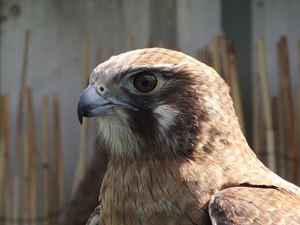Blog
Contact media@wires.org.au for enquiries or call 0416 272 153.
For the latest updates on bushfire recovery projects and emergency response
Read WIRES Emergency Recovery Plan and WIRES National Emergency Response Plan
Fast flying and youth combine to cause concussion
 During the next few months many juvenile birds of prey begin
dispersing to make their own way in the world and as these ‘teenagers’
venture forth, mistakes are made that result in injuries.
During the next few months many juvenile birds of prey begin
dispersing to make their own way in the world and as these ‘teenagers’
venture forth, mistakes are made that result in injuries.
Concussion seems to be a common thread as a result of flying and
judgement errors or perhaps just being in the wrong place at the wrong
time. These high speed flyers then come into contact with both human and
natural structures with a force that can have serious consequences. In
just the last few weeks one of our specialist raptor carers in the south
of the state has had two juvenile Boobook owls, a juvenile Nankeen
kestrel and a female Brown falcon in care, all suffering concussion!
This spectacular adult female Brown Falcon, was one recent patient.
Rodney, saw her collide with a structure and fall to the ground so as he
was working nearby he kept an eye on her to see if she would recover
and take off.
After watching for some time and seeing her starting to be attacked by
the local magpie flock and still unable to fly away he decided he had to
intervene.
Normally we do not advise people to approach birds of prey as they can
be large and feisty birds. In this instance the location was very remote
and she was very docile as a result of the concussion, so Rodney was
able to safely and gently contain the falcon. He then drove a
considerable distance to meet up with Shelly our local, trained raptor
carer.
Luckily for her x-rays, observation and flight checks cleared her of any
injury and she appeared back to full strength so the decision was made
to get her quickly back to the wild. At this time of year she may still
have had chicks in a nest.
Although both sexes of this species share incubation of the eggs and
both care for the young, it is the female who performs the bulk of these
duties while the male supplies most of the food.
The long drive was made back to where she was rescued and after
initially trying to exit from the rear of the cage, Shelly reports she
was soon airborne and another of our special native raptors was
successfully released.
These falcons are known to live for up to 18 years in the wild so we
hope she has a second chance at a long life back in the wild.
Search
Newsletter
Stay in touch and get our regular rescue stories, WIRES updates and a free copy of our 15 Ways to Help Wildlife ebook
Recent Posts
- Emergency Response Training for Wildlife Volunteers
- WIRES Introduces New Wildlife Rehabilitation Governance Courses in Collaboration with NPWS
- Community Support for Post-Bushfire Recovery of Wildlife in the Greater Blue Mountains
- Research Grants Program-2023 Recipients Announced
- National Koala Conference
- Nature Conservation Council's Bushfire Conference
- Support Stronger Nature Laws
- Helping Endangered Cockatoos: WIRES Grant Success Story
- Landmark Conservation Project Ensures The Future of The Northern Bettong
- Wildlife Road Collisions Unveiled
